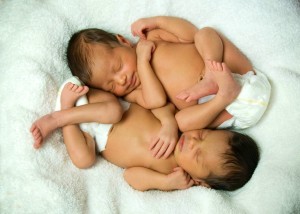My First Trimester
Week 3
Estimated Reading Time: 13 minutes During conception, the sperm’s nucleus with its 23 chromosomes, one of which determine the sex of your baby, will join with the egg’s nucleus containing an equal number of chromosomes, creating a single set of 46 chromosomes, a “zygote”. Your baby’s DNA, which is locked in these 46 chromosomes, establishes the baby’s sex, eye color, hair color and all the inherited attributes of a lifetime.
During conception, the sperm’s nucleus with its 23 chromosomes, one of which determine the sex of your baby, will join with the egg’s nucleus containing an equal number of chromosomes, creating a single set of 46 chromosomes, a “zygote”. Your baby’s DNA, which is locked in these 46 chromosomes, establishes the baby’s sex, eye color, hair color and all the inherited attributes of a lifetime.
If more than one egg is fertilized, you will have multiple zygotes, better known as twins, triplets, quadruplets and quintuplets.
Introduction To Depression
 Antenatal (or Prenatal) Depression is depression during pregnancy. Not only is it common, it may also continue or newly manifest as Perinatal Mood And Anxiety Disorder (PMAD) which encompasses a wide range of mood disorders after delivery and up to year after your baby is born. You may have signs of depression but not even be aware that you are depressed. It’s estimated that approximately 13 percent of pregnant women and new mothers experience depression. Every woman may have a few days where she feels sad, blue or down in the dumps. However with depression, the sad, anxious or empty feelings do not go away and your day-to-day routine and lifestyle changes because of these emotions. Your depression may present simply as feelings of unhappiness and gloom, or possibly spiral to feelings of overwhelming guilt, uncontainable hysteria or thoughts of inflicting harm on yourself or your baby.
Antenatal (or Prenatal) Depression is depression during pregnancy. Not only is it common, it may also continue or newly manifest as Perinatal Mood And Anxiety Disorder (PMAD) which encompasses a wide range of mood disorders after delivery and up to year after your baby is born. You may have signs of depression but not even be aware that you are depressed. It’s estimated that approximately 13 percent of pregnant women and new mothers experience depression. Every woman may have a few days where she feels sad, blue or down in the dumps. However with depression, the sad, anxious or empty feelings do not go away and your day-to-day routine and lifestyle changes because of these emotions. Your depression may present simply as feelings of unhappiness and gloom, or possibly spiral to feelings of overwhelming guilt, uncontainable hysteria or thoughts of inflicting harm on yourself or your baby.
 Depression is a mental illness that does tend to run in families. If you or your family has a history of depression or other mental illness, you may be more likely to experience depression during or after pregnancy. There is no single cause for depression. Your depression may be triggered by a combination of factors including the stressful events of everyday life. Maybe you are young, single and pregnant, experiencing a lack of support from your family and friends, a victim of physical abuse, or facing marriage or money difficulties. Perhaps there is substance abuse or a problematic pregnancy and birth in your past. Do you have anxious or negative feelings about your present condition? Are you caring for an aging family member or have you just lost a loved one? Unfortunately, any of these variables may become a trigger for your depression during or following pregnancy.
Depression is a mental illness that does tend to run in families. If you or your family has a history of depression or other mental illness, you may be more likely to experience depression during or after pregnancy. There is no single cause for depression. Your depression may be triggered by a combination of factors including the stressful events of everyday life. Maybe you are young, single and pregnant, experiencing a lack of support from your family and friends, a victim of physical abuse, or facing marriage or money difficulties. Perhaps there is substance abuse or a problematic pregnancy and birth in your past. Do you have anxious or negative feelings about your present condition? Are you caring for an aging family member or have you just lost a loved one? Unfortunately, any of these variables may become a trigger for your depression during or following pregnancy.
Women are at a greater risk of depression at certain times in their lives than men, and with some women hormonal factors may contribute to their depression. Research tells us that hormonal changes occurring within the brain chemistry that controls our emotions and mood may play a large role in depression.
Prenatal Depression
Growing up you may have experienced depressive symptoms right before menstruation. Some women experience depression during and following pregnancy because when pregnant, levels of the female hormones estrogen and progesterone surge. Then, in the first 24 hours after childbirth, hormone levels quickly return to normal levels leading researchers to believe that these extreme changes in hormone levels may lead to depression. Women may also experience hormonal and mood fluctuations during perimenopause.
It is normal to feel symptoms of mild depression-like feelings during and after pregnancy, but if your baby blues don’t go away after two weeks or you have any of the following symptoms for more than two weeks, you should speak to your health care team. Sadly, some women don’t tell anyone about their symptoms, worrying that they will be viewed as unfit parents. They feel embarrassed, ashamed, or guilty about feeling depressed when they are supposed to feel overjoyed at this time in their lives.
Symptoms of Prenatal and Postnatal Depression
You may experience:
- Feelings of restlessness, moodiness, sadness, hopelessness or being overwhelmed that may intensify.
- Crying a lot.
- Having no energy or motivation.
- Eating too little or too much.
- Sleeping too little or too much.
- Having trouble focusing, remembering, making decisions or performing tasks at work or home.
- Feeling worthless and guilty.
- Losing interest or pleasure in activities you used to enjoy.
- Withdrawing from friends and family.
- Having headaches, aches and pains, or stomach problems that don’t go away.
- Having trouble caring for yourself or your baby.
- Having thoughts of harming yourself or your baby.
Your symptoms will provide the basis for an accurate diagnosis from your health care team. Your doctor will ask the necessary questions to test for depression and may also refer you to a mental health professional that specializes in treating depression. Please know that depression does improve with treatment.
If you are already on medication for depression, stopping your medicine when you become pregnant or are breastfeeding could cause your depression to come back. You must be open and honest with your health care team regarding your depression and pregnancy. Do not stop any prescribed medicine without first talking to your doctor as not taking it could be harmful to you or your baby.
Untreated depression during pregnancy can hurt you and your developing baby, as you will have a difficult time caring for yourself. Depression may cause you to eat poorly, not gain adequate weight and suffer from insomnia. You may miss vital prenatal visits, become incapable of following medical instruction and even begin using harmful substance such as tobacco, alcohol or illegal drugs. Your baby may be small for his or her gestational age (SGA) and be born prematurely. Receiving professional treatment is important for both you and your baby.
Depression Treatment
In a recent study in the May issue of Obstetrics & Gynecology, researchers found that women with the symptoms of depression were associated with a 27 percent increased risk of delivering their babies before 37 weeks gestation, an 82 percent increased risk of delivering their babies before 32 weeks gestation, and a 28 percent increased risk of having a Small for Gestational Age (SGA) baby. But they also discovered that approximately one fifth of the expectant women that were treated with antidepressants for depression had no association with the increased risks for any of these problems with their babies.
 Dr. Kartik K. Venkatesh M.D., Ph.D., the study’s lead author and Clinical Fellow in Obstetrics, Gynecology and Reproductive Biology at Harvard states, “By screening early in pregnancy, you could identify those at higher risk and counsel them about the importance of treatment. Treating these women for depression may have real benefits.” Screening mothers early for depression is the key to not only their health but also that of their expected babies.
Dr. Kartik K. Venkatesh M.D., Ph.D., the study’s lead author and Clinical Fellow in Obstetrics, Gynecology and Reproductive Biology at Harvard states, “By screening early in pregnancy, you could identify those at higher risk and counsel them about the importance of treatment. Treating these women for depression may have real benefits.” Screening mothers early for depression is the key to not only their health but also that of their expected babies.
Following a diagnosis of depression, your may be treated with Talk Therapy that involves visiting a therapist, psychologist, or social worker to learn to change how depression makes you think, feel, and act. Or an Antidepressant Medication may be prescribed to relieve the symptoms of your depression. These treatment methods can be used alone or together. Talk with your doctor about the benefits and risks of taking medication while you are pregnant or breastfeeding. Other therapies such as exercise, acupuncture and support groups may be helpful.
Perinatal Mood And Anxiety Disorder (PMAD)
Did you realize that 1 in 5 women are diagnosed with mood disorders in the postpartum setting? Melissa Whippo, L.C.S.W. a Clinical Social Worker at the University of California, San Francisco’s (UCSF) Pregnancy and Postpartum Mood Assessment Clinic works with pregnant and postpartum women. She meets with women not only during pregnancy and after delivery, but also at any stage of their fertility process. Ms. Whippo emphasizes the single term “postpartum depression” fails to encompass the range of mood disorders women commonly experience in the postpartum setting, and although PMAD doesn’t roll off the tongue so easily, it is a more accurate description of depression in the postpartum period according to Ms. Whippo.
Untreated PMAD limits the ability of a new mom to parent. The symptoms of PMAD last longer and are more severe than depression during pregnancy. You may experience decreased energy, the inability to focus, moodiness and be incapable or disinterested in meeting your baby’s needs. You may also experience thoughts of hurting your baby or hurting yourself. Your feelings of guilt and losing confidence in yourself as a new mother will exacerbate your depression.
Researchers believe PMAD also affects your baby in numerous ways. It can cause your baby to have developmental language delays, difficulties with mother-child bonding, behavior problems and increased crying.
It’s not a well-known fact that low levels of thyroid hormones might mimic PMAD after you give birth as these levels may drop. Thyroid hormones regulate how your body uses and stores energy from food. Low levels of your body’s thyroid hormones may cause symptoms of depression. A simple blood test can tell if this condition is causing your symptoms. If so, your doctor can prescribe thyroid medicine.
Kristin Sample, writer, teacher, dancer and blogger immediately began her postpartum journey with extreme anxiousness and a quick weight loss of 25 pounds within the first two weeks of delivering her son Jackson. She wondered if this amazing feat was the result of breast feeding, pumping and healthy eating? In her heart, she realized something did not seem right.
Just two months later Kristen’s symptoms were reversed and she began experiencing relentless fatigue and effortless weight gain. Like many women in her situation, Kristin’s internist dismissed her new concerns of exceptionally low energy and unusually easy weight gain offering her Xanax and a consultation with a therapist for postpartum depression instead.
A simple blood test with her OB six months later revealed thyroid levels so low that Kristen’s doctor wondered how she could get herself out of bed in the morning and keep moving throughout the day. She learned that her initial extreme anxiousness and immediate weight loss occurring in the days following the birth of her son was the result of Postpartum Thyroiditis, a condition causing mild hyperthyroidism (overactive thyroid) symptoms.
 The undiagnosed postpartum thyroiditis Kristen initially experienced gave way to Hashimoto’s Disease, a potentially more serious and chronic thyroid condition in which the thyroid becomes underactive (hypothyroid). Medication was prescribed that enabled her to loose weight and increase her energy levels. An endocrinologist closely monitored Kristen’s second pregnancy adjusting her medication monthly as the thyroid is vital in helping the body stay pregnant. A mismanaged thyroid condition may result in miscarriage and stillbirth and is often undiagnosed until surrounding a pregnancy.
The undiagnosed postpartum thyroiditis Kristen initially experienced gave way to Hashimoto’s Disease, a potentially more serious and chronic thyroid condition in which the thyroid becomes underactive (hypothyroid). Medication was prescribed that enabled her to loose weight and increase her energy levels. An endocrinologist closely monitored Kristen’s second pregnancy adjusting her medication monthly as the thyroid is vital in helping the body stay pregnant. A mismanaged thyroid condition may result in miscarriage and stillbirth and is often undiagnosed until surrounding a pregnancy.
Every mom throughout her pregnancy journey must listen to her body and take care of herself. This will ensure that she stays in good health. The early days with a newborn can be draining for every new parent. Once your baby’s sleep schedule begins to normalize and you still do not feel like yourself before your pregnancy, speak with your doctor about PMAD or a possible thyroid problem. A simple blood test may just make all the difference!
Postpartum Anxiety Disorder
When you are a new mom, a certain level of anxiety is normal. However, when your anxiety starts to affect your ability to take care of yourself or your baby, it is time to see a medical professional for treatment. It’s estimated that about ten percent of new moms develop a significant anxiety disorder following delivery day. Postpartum Anxiety Disorder is manifested by an inability to relax and be still, racing thoughts, nonstop worrying, nausea, vertigo and faintness, and changes in sleep and appetite.
Postpartum Psychosis
Postpartum Psychosis for a new mom is rare but does exist. It occurs in about 1 to 4 out of every 1,000 births beginning in the first two weeks following delivery. Women who have bipolar disorder or another mental health problem called schizoaffective disorder have a higher risk for postpartum psychosis. Symptoms may include seeing things that aren’t there, confusion, rapid mood swings and trying to hurt yourself or your new baby.
Other PMAD Disorders
Postpartum Obsessive Compulsive Disorder (OCD) manifests as having unreasonable thoughts and fears that lead to a repetitive type of behavior. Developing OCD during or after pregnancy can be terrifying for women for many reasons but mainly because of the intrusive nature of repetitive thoughts. About three to five percent of new moms will experience OCD during their pregnancy or following delivery day. Intrusive thoughts such as, “What if I drop the baby, What if I forget the baby? or What if I stab the baby?” may plague an expectant or new mother.
Although a blessed event, childbirth can be traumatic for some moms. Postpartum Post-Traumatic Stress Disorder (PTSD) is more common in women who have had a problematic childbirth (including miscarriage, stillbirth, unplanned C-section, prolapsed cord, forceps deliver, or transfer of the newborn to the NICU), and in women who worry about childbirth, have experienced prior childbirth trauma, or have a history of PTSD. Symptoms may include constant anxiety, nightmares, avoiding people and places, and flashbacks to the traumatic experience.
Support During Depression
To be proactive, alleviate or help relieve the symptoms of depression during and after pregnancy, you may want to consider these helpful tips:
- Rest and get as much sleep as you can. If you have young children who are not sleeping though the night on a regular sleeping schedule, you may want to consider sleep training. Expecting another baby is a great motivator to have everyone sleeping at night on the same schedule.
- Don’t try to do too much or push yourself.
- Ask your partner, family, and friends for help, even for something as simple as a periodic nap.
- Make time to go out, visit friends, or spend time alone with your partner.
- Discuss your feelings with your partner, family and friends.
- Talk with other mothers so you can learn from their experiences.
- Join a support group. Ask your doctor about groups in your area.
- Don’t make any major life changes during pregnancy or right after giving birth. Major changes can cause unnecessary stress. Sometimes big changes can’t be avoided. When that happens, try to arrange support and help in your new situation ahead of time.
- Once your baby arrives, sleep when your baby sleeps. If you are breastfeeding, you may decide to “pump and sleep.” Meaning you will pump breast milk before you go to bed at night and your baby can be fed by the other parent, partner or family member while you get some sleep!
- After delivery day, consider finding outside support. If you want to manage your new life on your own, start figuring out how you can streamline your new responsibilities so caring for your new baby will receive your full attention making your life more manageable and enjoyable.
 If you are diagnosed with PMAD following your baby’s arrival, please realize that you are not alone and you are not to blame and with help you will feel like yourself again. It is vital to recognize your symptoms and seek the help of a qualified professional before your condition intensifies.
If you are diagnosed with PMAD following your baby’s arrival, please realize that you are not alone and you are not to blame and with help you will feel like yourself again. It is vital to recognize your symptoms and seek the help of a qualified professional before your condition intensifies.
If you are feeling depressed before, during pregnancy or after having your baby, don’t suffer alone. Please tell a loved one and call your health care team right away!
To learn more about depression before, during and after pregnancy, or for a list of organizations ready to assist you, please visit or call:
- National Maternal Mental Health Hotline, Call or text 1-833-TLC-MAMA (1-833-852-6262).
- Womenshealth.gov
- 988 Suicide & Crisis Lifeline, Call or text 988.
- Postpartum Support Charleston, Support Warm Line 843-410-3585.
- Postpartum Support International, HelpLine: 800-944-4773, Text in English: 800-944-4773, Text en Español: 971-203-7773.